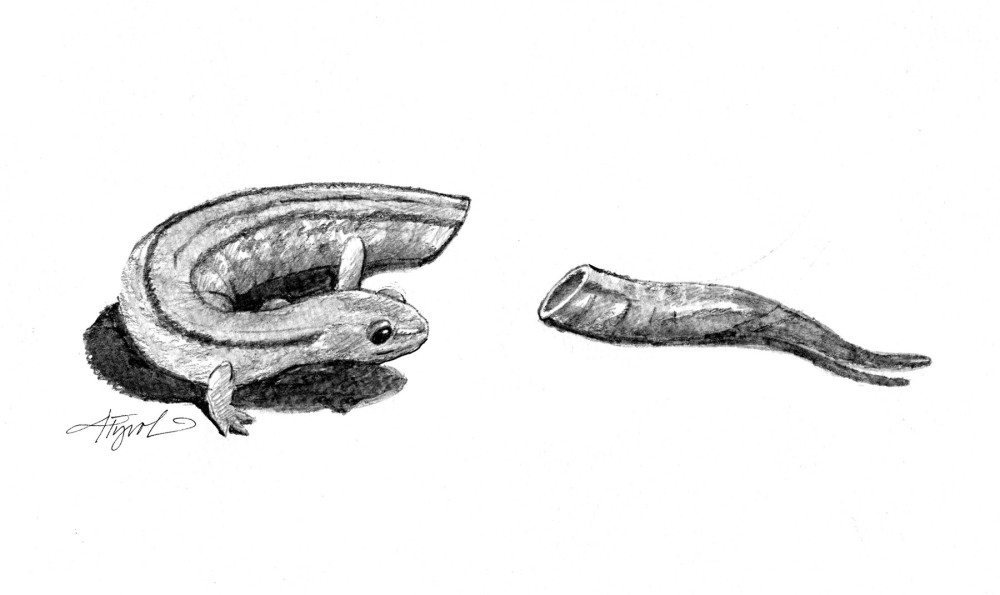
A few times a year, I bring groups of people into the woods to search for red-backed salamanders in the damp netherworld that is the forest floor. Last spring, it was 8th graders. They did their best to follow the cardinal rule of middle school social interaction – thou shalt not appear “uncool” by expressing interest in anything whatsoever that an adult is asking of you – but the salamanders exposed the chinks in their armor.
Crouched low over small wooden boards we’d set out to mimic the rotting logs that red-backeds prefer, the students murmured with excitement.
Amidst the usual exclamations (“I see one!” “Let’s name it Fred!”), one voice rang out above the others.
“It’s a snake! No, wait, it’s a worm! No, wait, it’s a...well, what is it, exactly?”
Peering down at the creature in question, I saw a two-inch-long, blue-gray appendage jutting vertically out of the soil, curling and uncurling like a beckoning finger. It was a tail. And it was no longer attached to the salamander from which it came.
Fearing predation by the herd of loud two-legged mammals nosing around in its territory, the salamander had detached the tail, left it wriggling there as a distraction, and scampered out of range.
This remarkable ability to sever one’s own limb without any outside assistance is known as autotomy, and it’s practiced by a number of species, including crabs, lizards, octopuses, spiders, moths, and of course our neighborhood red-backed salamanders. As you might imagine, the loss of a limb can significantly impair running, swimming, hunting, and predator evasion, not to mention reproduction. It works best, therefore, when bookended by an even more remarkable survival strategy: regeneration, or the replacement of a lost body part.
Among adult vertebrates, perfect regeneration is rare. Frogs can regrow tails when they’re tadpoles, but lose their regenerative ability upon metamorphosis. Adult lizards can also regrow tails, but the replacements differ demonstrably in form and function from the originals. Dr. Thomas Lozito, Assistant Professor at the University of Pittsburgh’s McGowan Institute for Regenerative Medicine, recently said in Science Daily, “You can easily tell a lizard with a regenerated tail. It doesn't get anything right. The scales are different; the color pattern is different; and then when you look inside the tail, all the tissues are different."
Salamanders and newts are a notable exception. Many salamander species retain their regenerative capabilities well into adulthood, and they’re not limited to tails, either. Newts can regenerate legs, jaws, spinal cords, retinas and lenses, even internal organs – in some cases, over and over and over again. A 2011 study found that individual newts could regrow lenses up to 18 times over the course of 16 years and up to age 30, each one good as new.
A 2000 literature review in Developmental Biology called amphibian regeneration of lenses, retinas, and limbs “the most complex and, therefore, the most spectacular [regeneration] of all” – unusually effusive language for a peer-reviewed scientific paper. In other words: it doesn’t get much more miraculous than restoring your own sight.
In 2014, researchers at Hartwick College in Oneonta, New York discovered that a newt can regenerate up to half its heart in just six weeks. To accomplish this astounding feat, the beleaguered amphibian forms a clot at the site of the wound to prevent blood loss, much like a cork in a wine bottle. Then, stem cells in the newt’s blood, including the clot itself, help the heart to regrow. Biomedical engineers are surely taking note.
Regeneration rates vary by species, body part, and environmental conditions, among other factors. While newt hearts can heal in as few as six weeks, lenses may take up to five months to regrow in full. Spotted salamander legs can take 250 to 300 days, starting as a nub at the wound site, moving through a “paddle” phase into differentiation of the digits, and finally the elongation of the limb itself. Along the way, bone, skin, nerves, blood vessels, tendons, cartilage, and muscle must all be created.
Back in the Harris Center woods, I regularly encounter red-backed salamanders in various stages of tail regeneration, the results of run-ins with raccoons, perhaps, or the errant footfalls of passing hikers. When I find one with a tiny, translucent triangle of new tail growth, I pause to imagine the moment of hurried escape, the bewildered raccoon left with nothing but a disembodied tail, the energy it must take to regrow an entire limb – and to marvel at the resilience of a creature that can let go of something so dear, then slowly and steadily make itself whole again.

